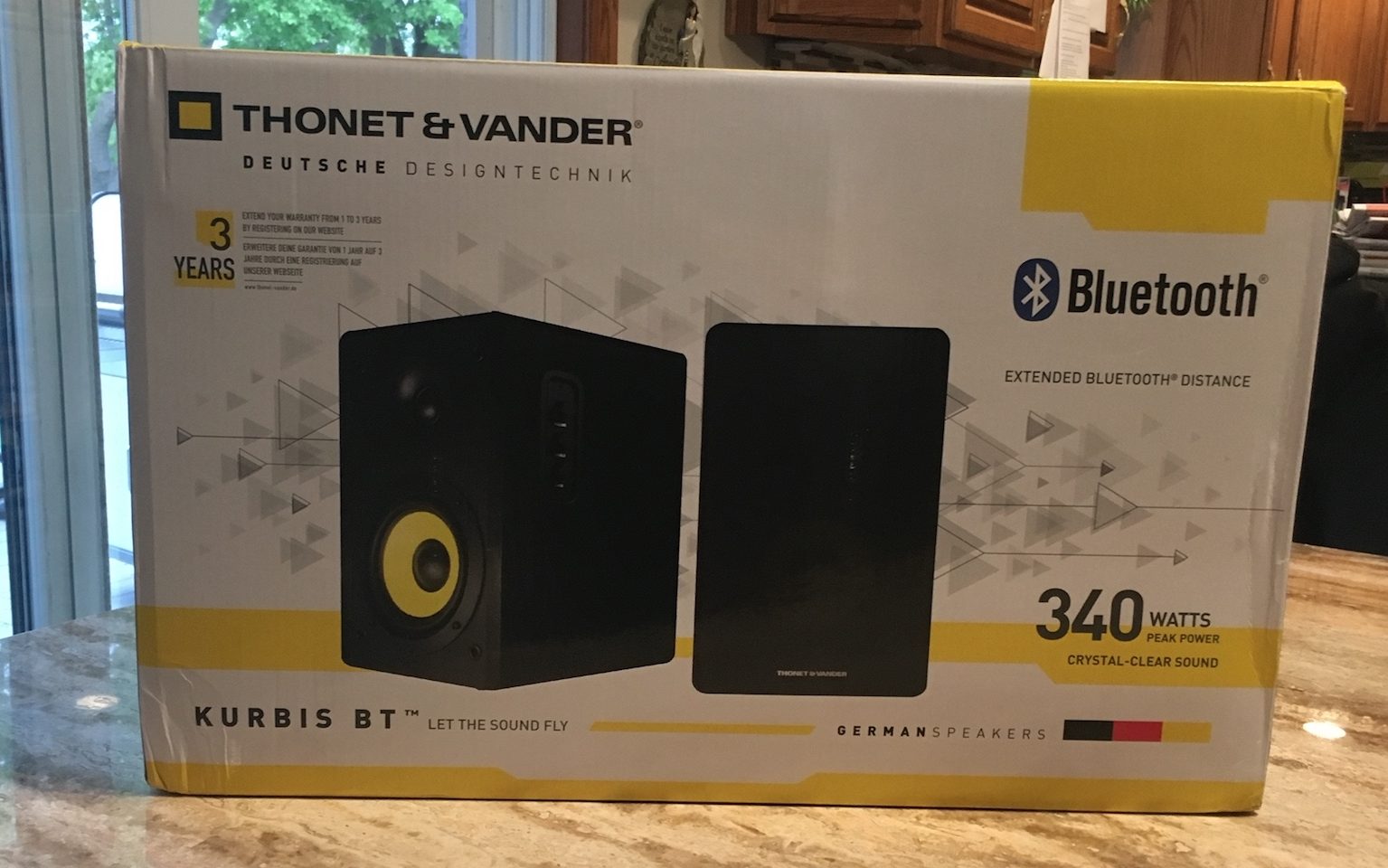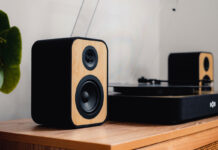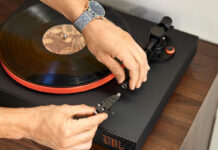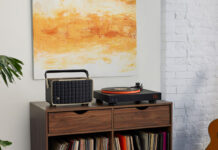
Thonet & Vander has a broad line of speakers with Bluetooth connectivity. Recently, the company upgraded one of their German-designed, mid-range speaker offerings: the KURBIS BT Bookshelf Bluetooth Speakers. I had a chance to test them in my home for a few days, and was pleasantly surprised by their quality and versatility.
In this review, we’ll cover the size and weight of the speakers, what’s in the box, build quality, controls, setup and sound quality.

Thonet & Vander – size and weight
Unlike other more portable Bluetooth speakers, you won’t be moving these speakers around a lot because of their size and weight; these are bookshelf speakers first with added Bluetooth capabilities. They’re meant to accompany a computer in your office or home studio, the record player in your den or the stereo receiver in your family room. Each KURBIS BT speaker weighs about nine pounds and stands at just under a foot tall. Like many other bookshelf speakers on the market, this device is about the same footprint as a Cajón drum.
In comparison, a small Bluetooth speaker will typically only stand a few inches tall and weigh about a pound.
Getting started with Thonet & Vander
This set of Bluetooth-enabled speakers have been on the market for a few years, but have recently been upgraded. The biggest upgrade is related to their peak power and RMS (Root-Mean-Square) value. The peak power has been upgraded from 300 to 340 watts and the RMS wattage also got a boost from 60 to 68 watts. Contributor Jeff Wilson wrote a piece about what these terms and numbers actually mean, but just know that these speakers get a very small upgrade to their maximum volume with the change. In my testing, I measured a peak loudness of 106.6dB.

What’s in the box?
The KURBIS BT speakers come tightly packaged in a full color box with everything that you need to get started. This includes the two Bluetooth speakers with removable speaker mesh, a power cord as well as a 3.5mm to RCA cable and speaker wire to connect the two speakers together.
They’re fairly simply to set-up: plug them in, connect the two speakers together using the included speaker wire and connect your audio source. The included speaker wire runs about six feet long, meaning your speakers can be spaced out across your desk on both sides of a widescreen monitor, for example.
Good build quality with Thonet & Vander
When you start to setup the speakers, you’ll first note that the build quality of  these speakers is pretty good. These German-engineered bookshelves are made from a special natural polymer called HDAA™ Wood. Some more portable Bluetooth speakers are usually made of plastic, but this weighty material feels and gives the appearance of a very high quality wood. In addition to its aesthetic appeal, the company’s High Density Acoustic Absorber (HDAA) Wood is meant to reduce vibration and prevent sound leakage.
these speakers is pretty good. These German-engineered bookshelves are made from a special natural polymer called HDAA™ Wood. Some more portable Bluetooth speakers are usually made of plastic, but this weighty material feels and gives the appearance of a very high quality wood. In addition to its aesthetic appeal, the company’s High Density Acoustic Absorber (HDAA) Wood is meant to reduce vibration and prevent sound leakage.
As with most speakers, the protective speaker mesh can be removed, in this case revealing a set of yellow cones on the woofers. These same cones are present on several other “studio-sized” bookshelf speakers like those made KRK Systems. The KURBIS BT speakers have 5.25″ Aramid fiber drivers and 1″ silk tweeters.
 Between the speaker size and build quality, these speakers would look great next to a stereo receiver or computer. The build quality is largely representative of a premium product, but wasn’t perfect. Compared to the speakers themselves, the speaker mesh felt cheap and there was some light discoloration near the edges of the inside of the mesh itself. This slight discoloration was also present on one of the speaker woofers. Thankfully, this slight problem didn’t affect the sound quality of the speaker. If you don’t want to use the speaker mesh, they’re very easy to remove thanks to a set of four pins on the corners of the cover.
Between the speaker size and build quality, these speakers would look great next to a stereo receiver or computer. The build quality is largely representative of a premium product, but wasn’t perfect. Compared to the speakers themselves, the speaker mesh felt cheap and there was some light discoloration near the edges of the inside of the mesh itself. This slight discoloration was also present on one of the speaker woofers. Thankfully, this slight problem didn’t affect the sound quality of the speaker. If you don’t want to use the speaker mesh, they’re very easy to remove thanks to a set of four pins on the corners of the cover.
How to control Thonet & Vander KURBIS speakers
The other speakers in the Thonet and Vander line of Bluetooth capable speakers (including the smaller VERTRAG and the more high-end KUGEL and TITAN offerings) have remotes, but on this unit, the controls are built right into the side of the active speaker. On the right-hand side of the active speaker, there are knobs where you can control the volume, bass and treble for both speakers. The control panel itself was great, but not having a remote was a small pain point.

Connecting to Bluetooth on KURBIS
Setting up these speakers was a breeze including connections to Bluetooth devices. When  you power the unit using the switch in the back of the active speaker, the unit will make an audible beep indicating that you can connect your Bluetooth capable device. This sound indicates that the device is in “discovery” mode, and can paired with a new or existing device. Once connected, you can play audio simultaneously from your Bluetooth audio source and from another source (either the AUX or RCA connections).
you power the unit using the switch in the back of the active speaker, the unit will make an audible beep indicating that you can connect your Bluetooth capable device. This sound indicates that the device is in “discovery” mode, and can paired with a new or existing device. Once connected, you can play audio simultaneously from your Bluetooth audio source and from another source (either the AUX or RCA connections).
You can only connect one Bluetooth device at a time but the connection range was good. It also was simple to disconnect a device and reconnect another one rapidly.
If you had multiple Thonet and Vander Bluetooth speakers in your home, you could opt for the optional Multi-Room Audio Hub. This device (sold separately) allows you to connect up to 3 speakers. This is a common feature for Wi-Fi based wireless speakers, but less so for Bluetooth speakers. If you tend to roam around your house and worry about Bluetooth connectivity, this device will extend the range of your speakers to up to 1,000 feet. To control the audio in your home, the hub comes with a free iOS or Android app.
The Thonet & Vander solution for multi-room audio is a bit costly. If multi-room functionality is a primary purchasing criteria, you may want to opt for Wi-Fi option over one with Bluetooth. For more information about your multi-room audio options, you can check out this how-to guide about selecting multi-room audio devices for your home.
Sound Quality: Thonet & Vander KURBIS
The most important question remains: how do they sound?
Despite being 2.0 speakers, coming without a subwoofer, these mid-sized bookshelf speakers pack a pretty mean punch. Additionally, even at very high volumes (80%+), there was no discernible sound distortion. Thonet & Vander touts two particular features that help provide that clear audio. First, Hammer Bass™ boosts the low-end capabilities of the speakers (the published frequency response on the KURBIS BT unit is 55Hz – 20,000Hz). Nothing beats having a subwoofer, but the bass was surprisingly good for the unit’s size and form factor. Second, Thonet & Vander’s Drone FX™ technology elevates sound quality throughout the entire audio range.
Regardless of the genre of music, sound was clear. The panning background vocals in Wale’s “LoveHate Thing” were clear, Drake’s vocals cut through the very bass-filled “I’m On One” by DJ Khaled and the saxophone was very pronounced as intended in The Midnight’s “Crystalline”. I also played a few podcasts with varied audio setups and they sounded great.
For my testing, I tended to keep the treble at the default setting but turned up the bass to accentuate the low-end frequencies of my tunes.
Is the Thonet and Vander KURBIS BT a good pick?
All in all, these were a great pair of entry-mid level speakers. For the price, they packed a surprising amount of volume for their size and had a good build quality to them. However, don’t let the title deceive you: these are bookshelf speakers first with the added Bluetooth connectivity. It’s an excellent bonus for convenience if you wanted to connect Bluetooth devices on an ad-hoc basis.
If you’re looking for a Thonet and Vander speaker with more power, check out our review of the KUGEL speaker, the big brother to the speaker in this review.



